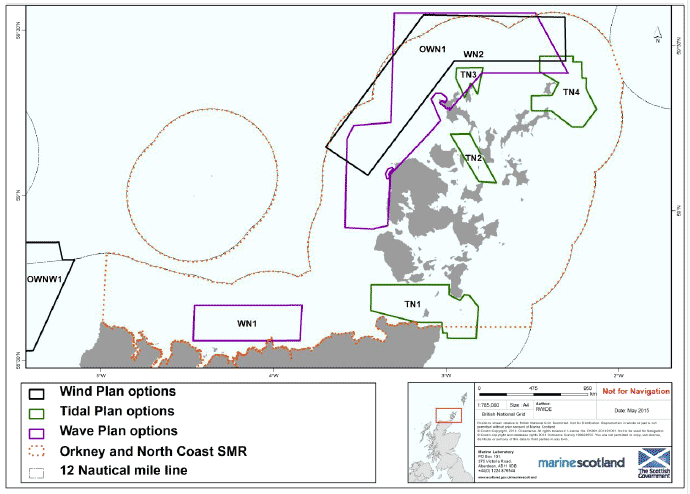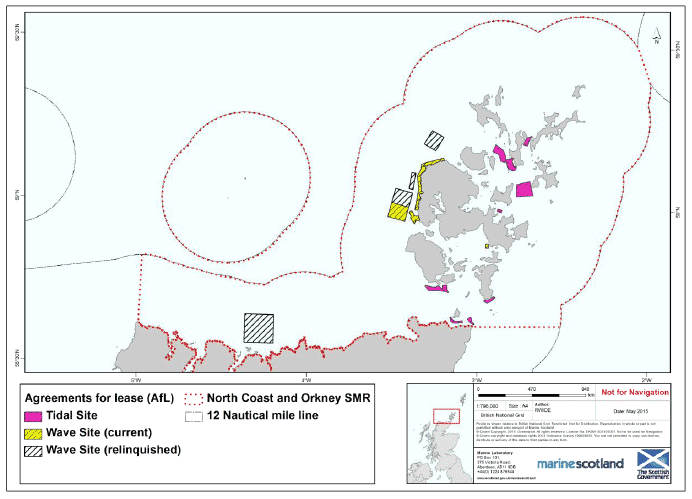Pilot Pentland Firth and Orkney Waters Marine Spatial Plan - Regional Locational Guidance
This Regional Locational Guidance collates information from a wide variety of sources to assist the wind, wave and tidal energy developers in situating their developments.
1 Introduction
1.1 Regional Locational Guidance
1.1.1 This Regional Locational Guidance ( RLG) has been produced as part of the process of developing a pilot Pentland Firth and Orkney Waters ( PFOW) Marine Spatial Plan ( MSP). The PFOW area is based on the Scottish Marine Regions ( SMR) of Orkney and North Coast. The information is aimed at assisting developers in the wind, wave and tidal renewable energy industry to choose sites of maximum opportunity and minimum constraint. Opportunities are defined as available environment or infrastructure that encourage the efficient and streamlined licensing and development of offshore renewables projects. Constraint is defined as issues that may create obstacles or barriers to such development.
1.1.2 Opportunities can include resource areas, grid connections and port facilities. Constraints can include fishing grounds, shipping lanes and environmental designations.
1.1.3 The RLG can also be used as guidance to establish test and demonstration sites.
1.2 Background documents
1.2.1 This work is based on the RLGs that were produced for the Sectoral Marine Plans and have been adapted to the PFOW area. Region specific data and information have been added where available and updates of the data sets used in the sectoral plans have been included into this report.
1.2.2 The RLGs and Sectoral Marine Plans can be found online [1] .
1.3 Plan options
1.3.1 Sectoral Marine Plans are being developed to ensure that offshore renewable energy sources such as wave, tidal and offshore wind, will make a full contribution to meeting Scotland's ambitious decarbonisation targets in a sustainable manner. Sectoral Marine Plans will be adopted into the statutory National and Regional Marine Plans.
1.3.2 The aims of the Sectoral Marine Plans are to:
- Maximise the contribution that offshore renewable energy makes to renewable energy generation in Scotland
- Maximise opportunities for economic development, investment and employment
- Minimise adverse effects on people, other sectors and the environment
1.3.3 The Sectoral Marine Plans resulted in a number of Plan Options ( PO) being developed. These represent development zones, a proportion of which could be used for development of the wind, wave and tidal industry.
1.3.4 In the PFOW area the Plan Options are: one offshore wind site ( OWN 1), two wave sites ( WN1 and WN2) and four tidal sites ( TN1, TN2, TN3 and TN4). These are shown in Figure 1 and Table 1.
Figure 1: Plan Options for wind, wave and tidal developments in the PFOW.

Table 1. Names and abbreviations for the Plan Options within the PFOW area.
| Site Name | Code | Code description |
|---|---|---|
| North of Orkney | OWN1 | Offshore Wind North 1 |
| North Sutherland Coast | WN1 | Wave North 1 |
| North and West of Orkney | WN2 | Wave North 2 |
| Pentland Firth | TN1 | Tidal North 1 |
| Orkney, Westray and North East Sanday | TN2, TN3 and TN4 | Tidal North 2, 3 and 4 |
1.4 Crown Estate Agreement for Lease Areas
1.4.1 Following a leasing round held in 2010 by the Crown Estate in the PFOW area there are now twelve Agreements for Lease (AfL) issued to developers. These AfLs have a potential capacity of up to 1,600 MW [2] .
1.4.2 In early 2015 four of these sites were handed back to the Crown Estate. This was to enable greater clarity for this emerging sector as developers map and align their agreements to their current development plans and aspirations. The original twelve AfLs and the four that were relinquished in 2015 are shown in Figure 2.
Figure 2: Agreement for lease sites for wave and tidal energy developments in the PFOW area.

1.4.3 An AfL is a conditional right for the developer to request a lease once all the necessary statutory consents for the project have been obtained. This arrangement enables the developer to have confidence that investment in the development of the site is protected from other competing interests for the period of the AfL.
1.4.4 The developer is responsible for obtaining all the necessary statutory consents. Once this is done the Crown Estate can grant the lease and this will enable construction to go ahead.
1.5 Background to pilot Pentland Firth and Orkney Waters Marine Spatial Plan
1.5.1 The process of developing a pilot PFOW Marine Spatial Plan (the Plan) has been undertaken by a working group consisting of Marine Scotland, Orkney Islands Council and Highland Council. This RLG will form part of a suite of documents that will support the evidence base of the Plan.
1.5.2 The working group have produced a number of documents to develop the Plan. More information can be found at the Marine Scotland's online [3] site, a brief overview is given below.
- A Plan Scheme was produced in November 2012 and outlined the proposed approach of developing the MSP and noted when there would be opportunities for stakeholder input.
- A Planning Issues and Options Paper ( PIOP) and a draft Environmental Report ( ER) were published in 2013 and were subject to a consultation in July 2013. The PIOP set out a range of options for future marine development and management in the PFOW and provided planning options to support the preparation of the Plan. The draft ER was carried out as part of the Strategic Environmental Assessment ( SEA) and outlined how the working group were assessing the environmental impact of the Plan.
- Following the consultation process two related documents were produced, a Consultation Analysis (Nov 2013), which analysed the responses received in relation to the consultation and a Consultation Report (April 2014), which outlined a number of actions for the working group in response to the comments received.
1.5.3 The working group then started the process of drafting the Plan itself and the associated supporting documents of which this RLG is one. The Plan and supporting documents will be published and undergo a formal twelve week consultation in 2015.
1.5.4 Following the formal consultation the working group will finalise and revise the Plan and associated documents ready for ministerial approval before adopting the Plan.
1.5.5 It is anticipated that, once adopted, the Plan will be reviewed on a timetable to be agreed during consultation. However, it is likely that the RLG will be updated as and when necessary and when new data become available.
1.6 Considerations when using the RLG
1.6.1 An RLG is developed using the best available data and knowledge but it should be taken into account that there are differences in what each data sets represents and also in how it has been collected and verified.
1.6.2 Although the data sets all provide useful and relevant information it should be emphasised that owing to the different methods of collection, verification and spatial extent of the data the RLG should be considered as a guide to marine spatial planning rather than a definitive answer as to the exact location for marine developments. Some data sets have been collected over a number of years and have had some form of verification or quality assurance, for example the location of aquaculture farms. Others are based on more sporadic data collection and may not have such rigorous data owing to how the data have been collected, e.g. basking shark sightings.
1.6.3 An RLG is one of a range of tools that can be used to choose sites of maximum opportunity and minimum constraint but is not intended to be a stand-alone method of doing so. Marine Scotland publishes a suite of documents that aim to cover the requirements for licensing bodies, lease providers and offshore developers.
1.7 Overview of RLG structure
1.7.1 Section 3 of the report provides an overview of wind, wave and tidal resource in the PFOW area. Information is provided on the available resource for each PO and a figure illustrating the resource is provided.
1.7.2 Section 4 discusses the different sectoral information for the PFOW. Each sub-section provides some background information on the specific sector.
1.7.3 Within both these sections the information is represented on a figure that displays the POs and the Crown Estate AfL areas (as of May 2015). This illustrates the spatial information in relation to these sites.
Contact
There is a problem
Thanks for your feedback